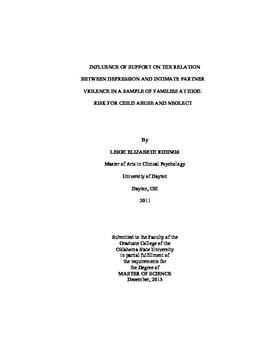| dc.contributor.advisor | Beasley, Lana Olivo | |
| dc.contributor.author | Ridings, Leigh Elizabeth | |
| dc.date.accessioned | 2015-06-17T20:07:41Z | |
| dc.date.available | 2015-06-17T20:07:41Z | |
| dc.date.issued | 2013-12-01 | |
| dc.identifier.uri | https://hdl.handle.net/11244/19483 | |
| dc.description.abstract | Intimate partner violence (IPV) is a costly concern that affects millions of U.S. families per year. IPV cuts across socio-economic strata and occurs across various cultures, affecting individuals on many levels. In addition to experiencing other outcomes, many individuals affected by IPV report experiencing depressive symptoms. Consequently, the combination of IPV and depressive symptoms leads to problems within the family as well as poor child outcomes. Further, IPV and depression serve as two main risk factors for child abuse and neglect. Previous research suggests that certain protective factors exist to buffer against the harsh effects of IPV and depression, thereby decreasing the likelihood of child abuse and neglect. An additional factor that is positively associated with both IPV and depression is a history of child maltreatment (CM). CM history has been shown to serve as a risk factor for IPV and depression, and often places caregivers at risk for child abuse and neglect into adulthood. The purpose of the present study was to examine the longitudinal impact of protective factors--namely social support, family resources, and church attendance--and child maltreatment history on the relation between IPV and depression in a sample of families at high-risk for child abuse and neglect. It was first hypothesized that IPV victims with higher levels of supports (i.e., social support, family resources, and/or church attendance) would report lower depression symptoms over time, while IPV victims with a CM history would report higher depressive symptoms over time, controlling for other study variables. It was also hypothesized that distinct subgroups would exist within the study sample with respect to the presentation of depression status over time. Lastly, it was hypothesized that support variables and CM history would impact the relation between IPV and depression over time differently within each subgroup. Results of hypotheses one and three were not supported, although main effects of these variables on depression were significant over time. Results supported hypothesis two, as a two-group linear trajectory model best fit participant depression status. Future research should examine the impacts of differing categories of IPV on depression, and how support variables impact these relations. | |
| dc.format | application/pdf | |
| dc.language | en_US | |
| dc.publisher | Oklahoma State University | |
| dc.rights | Copyright is held by the author who has granted the Oklahoma State University Library the non-exclusive right to share this material in its institutional repository. Contact Digital Library Services at lib-dls@okstate.edu or 405-744-9161 for the permission policy on the use, reproduction or distribution of this material. | |
| dc.title | Influence of Support on the Relation Between Depression and Intimate Partner Violence in a Sample of Families at High-risk for Child Abuse and Neglect | |
| dc.type | text | |
| dc.contributor.committeeMember | Mullins, Larry L. | |
| dc.contributor.committeeMember | Sullivan, Maureen | |
| dc.contributor.committeeMember | Silovsky, Jane | |
| osu.filename | Ridings_okstate_0664M_13158.pdf | |
| osu.accesstype | Open Access | |
| dc.description.department | Psychology | |
| dc.type.genre | Thesis | |
| dc.subject.keywords | child abuse and neglect | |
| dc.subject.keywords | depression | |
| dc.subject.keywords | family resources | |
| dc.subject.keywords | high-risk | |
| dc.subject.keywords | intimate partner violence | |
| dc.subject.keywords | social support | |
